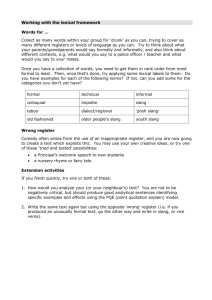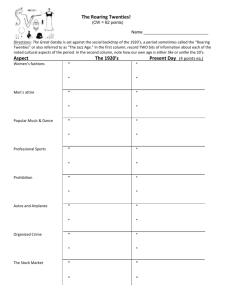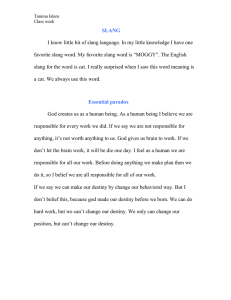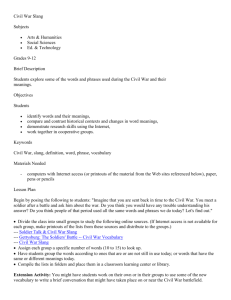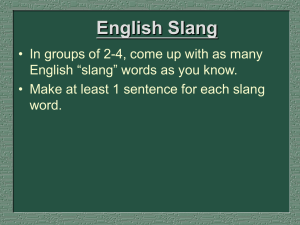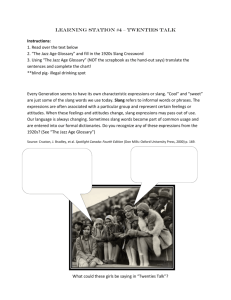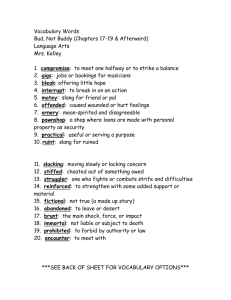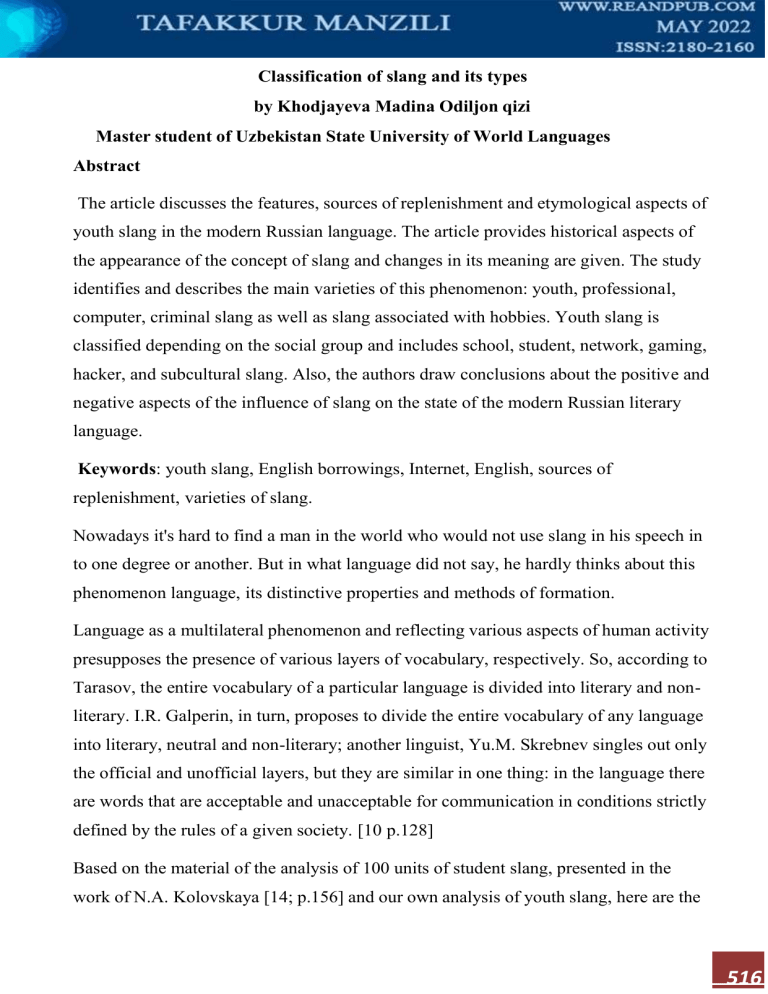
Classification of slang and its types by Khodjayeva Madina Odiljon qizi Master student of Uzbekistan State University of World Languages Abstract The article discusses the features, sources of replenishment and etymological aspects of youth slang in the modern Russian language. The article provides historical aspects of the appearance of the concept of slang and changes in its meaning are given. The study identifies and describes the main varieties of this phenomenon: youth, professional, computer, criminal slang as well as slang associated with hobbies. Youth slang is classified depending on the social group and includes school, student, network, gaming, hacker, and subcultural slang. Also, the authors draw conclusions about the positive and negative aspects of the influence of slang on the state of the modern Russian literary language. Keywords: youth slang, English borrowings, Internet, English, sources of replenishment, varieties of slang. Nowadays it's hard to find a man in the world who would not use slang in his speech in to one degree or another. But in what language did not say, he hardly thinks about this phenomenon language, its distinctive properties and methods of formation. Language as a multilateral phenomenon and reflecting various aspects of human activity presupposes the presence of various layers of vocabulary, respectively. So, according to Tarasov, the entire vocabulary of a particular language is divided into literary and nonliterary. I.R. Galperin, in turn, proposes to divide the entire vocabulary of any language into literary, neutral and non-literary; another linguist, Yu.M. Skrebnev singles out only the official and unofficial layers, but they are similar in one thing: in the language there are words that are acceptable and unacceptable for communication in conditions strictly defined by the rules of a given society. [10 p.128] Based on the material of the analysis of 100 units of student slang, presented in the work of N.A. Kolovskaya [14; p.156] and our own analysis of youth slang, here are the 516 main lexical mechanisms for the formation of slang units that are universal for any type of slang: 1. Affixation - attaching an affix to the base. At the same time, affixes, prefixes and suffixes can differ not only in place in the word, but also in the degree of independence. For example: friendly, postwar. 2. Abbreviation: USA, FBI, pro - professional, biz - business, 313 - Detroit, 411 information, Lil` - small. 3. Compounding - obtaining new words by adding several. For example: pen-holder, baby-sitter. 4. Conversion - inverse relations of language units in the original and derived statements: to jolly - to amuse, and sneak - a person informing on another, to fiend - to crave something, to be dependent. 5. Reduplication - doubling words: bye-bye, tip-top. Consider some types of slang and their role in modern society. 1. "Rhyming slang" (Cockney rhyming slang). The expressions of this kind of slang are several related words, the last of which must rhyme with the word that is the true meaning of the phrase. One of the most famous examples, which is very rarely used in serious conversations, is the expression apples and pears, which means stairs. Usually rhyming slang expressions are reduced to the first word when used frequently, so the example considered would look like just apples. A speech delivered in Cockney rhyming slang resembles a cipher, the meaning of which cannot be recognized without a key [11; c. 129]. Rhyming cockney slang is quite common in modern English speech. Here are some expressions that are firmly rooted in everyday speech: "Let's have a butchers at that magazine" (butcher's hook = look) 2. "Mobile" slang. 517 A new language has been born among American teenagers based on predictive text input when sending sms from mobile phones. Those words that teenagers have in mind, they replace the first option that the system offers. So if you notice that someone says "book" (book) about something, it means "cool" (cool), because "book" is the first word that the phone suggests when you type "cool" . When they say "zonino!", they mean "woohoo!" (both are joyful exclamations), and calling someone "nun" (nun), they talk about their "mum" (mother). If someone says that he is in a "sub" (sub), it means that they are with friends in a "pub" (pub). When they bring a “pint” (pint) of beer, it turns into a “shot” (shot), and “barmaid” (barmaid) becomes “carnage” (massacre, carnage) [1; c. 371]. 3. Student slang. The study of student slang made it possible to identify the priorities of modern students. Essentials such as food (grazing; celebration - caning) and clothing (trousers - kegs; underwear - shreddies) are only 12th and 13th respectively out of 15 identified categories. In second place, after alcohol and drugs, are the terms associated with expressing approval. The next most important are words related to love relationships. Phrases such as "on the sniff", "out trouting", "chirpsing" and "sharking" indicate flirting, while the words "lumbering" and "copping off" indicate that the acquaintance has achieved its goal. The vocabulary associated with the educational process is only 23%, however, this is a group of words that is diverse in etymology and structure [16; c. 143]. In a modern industrialized society, the language is very mobile, which is why over the period of a single generation, its vocabulary undergoes major changes. Slang is the communication of people of the same age category, opposing oneself to the older generation and officialdom. We have given the main lexical mechanisms based on the analysis of student slang: affixation, abbreviation, compounding, reduplication and conversion. And in the end, I would like to note that young people, being the predominant carrier of slang, and therefore the words that yesterday were considered 518 profanity, today are already the norm, are rapidly spreading and fixed in the vocabulary of society. References: 1. Galperin, I.R. On the term "slang" // Questions of linguistics / I.R. Galperin. - 1956. No. 6. - S. 114-150. 2. Burdin, L.S. Dictionary mark "slang" and interpretation in modern linguistics // Questions of linguistics and methods of teaching foreign languages / L.S. Burdin. - M., 2002. - S. 67-79. 3. Khomyakov, V.A. Introduction to the study of slang - the main component of the English language / V.A. Khomyakov. - Vologda: Regional Printing House, 1971. - 103 p. 4. Voloshin, Yu.K. American slang in colloquial speech // Linguistic units of different levels and their functional characteristics / Yu.K. Voloshin. - Krasnodar, 2002. - S. 1317. 5. Lipatova A.T. Slang as a problem of sociolinguistics.– M.: Elpis. 2010.– 20 p.m. 6. Macmillan English Dictionary for Advanced Learners, London United Kingdom: Macmillan Publishers Limited, New Edition 2007.– 1401 p 7. Matyushenko E.E. Modern youth slang: Formation and functioning. The dissertation for the degree of candidate of philological sciences.–Volgograd: Voronezh State Pedagogical University. 2007.– 35 p. 8.Vilyuman V.G. About ways of formation of slang words in modern English // Scientific notes of the Herzen State Pedagogical University, materials of “the Herzen Reading”. – Vol. 111. – No. 6. 1960. – P. 137–139. 519
